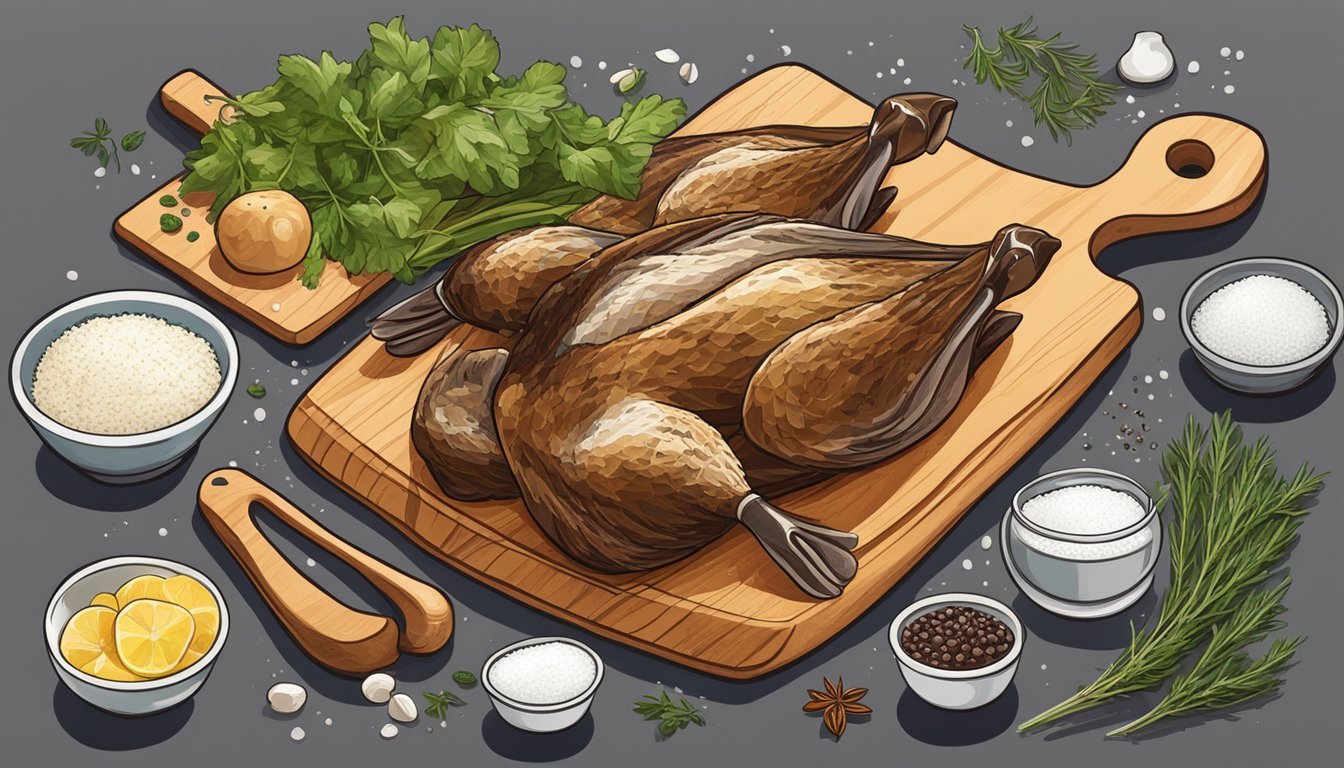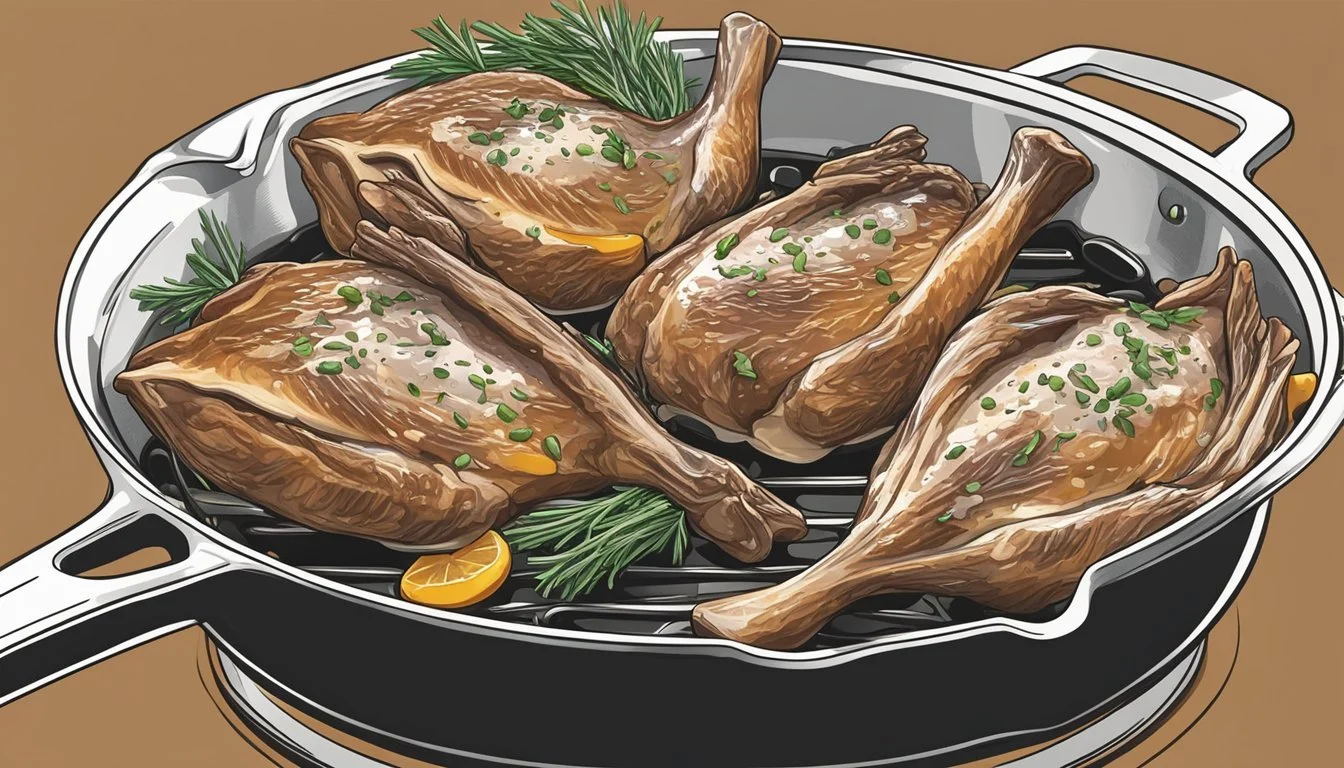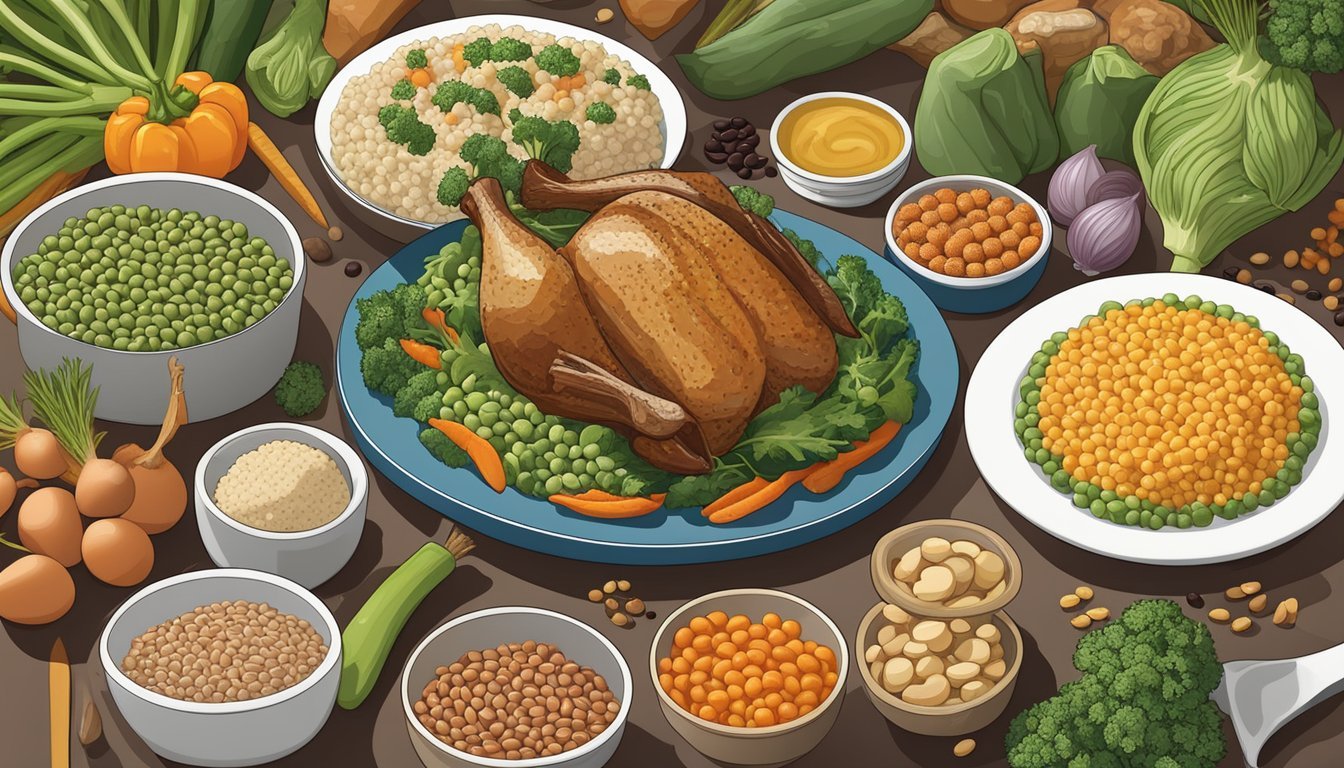Duck Legs Substitutes
Top Alternatives for Your Recipes
Finding the perfect substitute for duck legs can elevate your culinary creations, whether you're crafting a gourmet meal or a quick weeknight dinner. Chicken thighs make an excellent alternative, offering a similar richness and juiciness thanks to their dark meat and higher fat content. Easily marinate and roast them to create a dish that's both flavorful and satisfying.
Other options include turkey thighs, which provide a slightly gamey taste reminiscent of duck but come in a larger size, making them perfect for generous servings. For those looking for a non-poultry option, pork shoulder can be a surprising but delightful substitute, delivering robust flavor and tender results when cooked properly.
Experimenting with different substitutes can lead to exciting and delicious discoveries, ensuring that a lack of duck legs never halts your culinary ambitions.
Understanding Duck Legs
Duck legs are a popular culinary ingredient known for their rich flavor and tender meat. They are composed of the thigh and drumstick portions of the duck, offering a distinctive taste that stands out from other poultry.
The meat of duck legs is dark and succulent, owing to the higher fat content compared to chicken or turkey. This fat renders during cooking, infusing the meat with a deep, savory flavor.
Nutritionally, duck legs provide significant protein along with essential vitamins and minerals like iron and zinc. They also contain higher levels of fat, making them a hearty choice for those looking to add more richness to their diet.
When cooking duck legs, they can be prepared in various ways, including roasting, braising, and slow-cooking. Each method allows the fat to render slowly, resulting in tender and flavorful meat.
Duck legs are often used in classic dishes such as confit, where the legs are slowly cooked in their own fat. This traditional preparation enhances the meat’s tenderness while preserving its unique flavor.
For those looking to replicate the taste and texture of duck legs without using duck, chicken thighs are a common substitute. They offer a similar dark meat profile and fat content, providing a comparable culinary experience.
Essential Ingredients for Duck Leg Recipes
Duck leg recipes require a specific set of ingredients to bring out the rich flavors and tender texture of the duck. Key ingredients include primary components, herbs and spices, and additional flavor enhancers.
Primary Ingredients
Duck legs are the star. They should be fresh and of good quality. Salt and pepper are critical for basic seasoning, ensuring the meat's natural flavors shine.
Duck fat is often used during cooking to keep the meat moist and enhance the flavor. Other relevant ingredients include:
Onions: Add sweetness and depth.
Garlic: Provides a savory, aromatic kick.
Chicken thighs: A suitable substitute if duck legs are unavailable.
Herbs and Spices
Herbs and spices are essential to achieving a complex flavor profile. Thyme, rosemary, and bay leaves are common herbs that pair well with duck.
Salt and Pepper: These are the basic seasonings.
Thyme: Adds a woody, aromatic taste.
Chinese Five-Spice: Contains star anise, cloves, Chinese cinnamon, Sichuan peppercorn, and fennel seeds, commonly used in Asian-inspired duck dishes.
Fennel: Introduces a sweet, licorice-like flavor.
Bay Leaves: Impart subtle bitterness.
Additional Flavor Enhancers
Additional flavor enhancers often come in the form of sauces and marinades. Soy sauce, hoisin sauce, and honey are frequently used in marinades to offer sweetness and umami.
Soy Sauce: Introduces a salty, umami flavor.
Hoisin Sauce: Adds sweetness and savory elements.
Honey: Balances spiciness and acidity with sweetness.
Wine: Both red and white wines can elevate the richness of the dish.
These ingredients together create a harmonious balance, amplifying the duck's natural flavors and ensuring a memorable meal.
Cooking Techniques for Duck Legs
Cooking duck legs involves methods that enhance their rich flavor and tender texture. Key techniques include roasting, braising, and preparing duck confit. Each method requires specific steps to achieve the best results.
Roasting
Roasting duck legs creates a crispy exterior while keeping the meat juicy. Preheat the oven to 300°F. Marinate the legs with spices like salt, pepper, and Chinese five-spice. Place them in a small baking dish, skin-side up, so the rendered fat can baste the meat. Roast for 1.5 hours, occasionally basting with the fat. For extra crispiness, finish by increasing the oven temperature to 425°F for 10 minutes. Roasting ensures evenly cooked, flavorful duck legs.
Braising
Braising is ideal for tenderizing duck legs. Begin by browning the legs in a hot skillet to render some fat and develop flavor. Remove the legs and pour off excess fat, leaving enough to cook the vegetables. Add aromatic vegetables like onions, carrots, and celery, and cook until they start to brown. Return the duck legs to the skillet, add broth, cover with aluminum foil, and cook in a 300°F oven for about 2 hours, or until tender. Braising melds the flavors and yields succulent, fall-off-the-bone duck legs.
Confit Preparation
Confit is a classic French technique for preserving and cooking duck legs. Salt the legs generously and let them cure in the refrigerator for 24 hours. Rinse and dry the legs, then place them in a baking dish with enough duck fat to cover. Cook slowly at 275°F for 2-3 hours until the meat is tender. Store the legs in the cooking fat for preservation. When ready to serve, crisp the legs in a hot skillet. Confit preparation produces rich, deeply flavored duck legs that keep well for later use.
Alternatives to Duck Legs
For those seeking substitutes for duck legs, a variety of options can provide a comparable taste and texture. These alternatives cover both poultry and non-poultry choices and are suitable for different culinary uses.
Duck Breast Substitutes
Chicken Thighs
Chicken thighs are a great substitute for duck breasts due to their dark meat and rich flavor. When marinated and roasted, they maintain juiciness similar to duck. They are also readily available and more affordable.
Turkey Thighs
Turkey thighs offer a slightly gamier taste than chicken thighs, making them a closer alternative to duck. They work well in slow-cooked dishes or when roasted to retain moisture and flavor.
Poultry Alternatives
Goose Legs
Goose legs are an excellent substitute for duck legs, providing a similar texture and richness. They are ideal for confit and roasted dishes, where the fat content ensures a succulent result. Goose legs also have a strong, savory flavor that stands up well to robust seasonings.
Quail
Quail, though smaller, can be used in place of duck legs for a delicately flavorful experience. Quail's tender meat makes it suitable for quick roasting or grilling, ideal for recipes requiring a milder poultry taste.
Non-Poultry Options
Pork Shoulder
Pork shoulder is a versatile substitute for duck legs in many recipes. Its marbling ensures moist and flavorful results whether roasted or slow-cooked. Pork shoulder's rich taste can absorb a wide range of marinades and spice rubs.
Lamb Shank
Lamb shank can mimic the hearty nature of duck legs, especially in stews and braised dishes. Its robust flavor pairs well with strong herbs and spices, offering a satisfying alternative for those looking for something different from poultry.
Use these alternatives depending on the dish at hand and the flavor profile desired. Each option brings its unique qualities to the table, ensuring delicious results.
Key Recipe Instructions
Preparing duck leg substitutes such as chicken thighs involves a straightforward process, including preparation, cooking, and serving. This guide offers comprehensive instructions on transforming chicken thighs into a delicious alternative to duck legs.
Preparation Guide
The key to a successful dish starts with proper preparation. Chicken thighs are the recommended substitute due to their similar texture and flavor profile. Begin by marinating the chicken thighs in a mixture of herbs, garlic, and olive oil for at least two hours or overnight for enhanced flavor absorption.
Salt is essential for seasoning. Sprinkle kosher salt generously over the chicken thighs. For additional depth, consider incorporating soy sauce or Worcestershire sauce in the marinade. Refrigerate the marinated chicken thighs until ready for cooking. Ensure the thighs are at room temperature before proceeding to the next step.
Cooking Directions
Cooking chicken thighs requires careful timing and temperature control. Preheat the oven to 375°F (190°C). For optimal results, start by searing the marinated chicken thighs in a cast-iron skillet over medium-high heat until the skin is golden brown. This step takes approximately 5-7 minutes.
Transfer the skillet to the oven and continue cooking. Bake for 25-30 minutes until the internal temperature reaches 165°F (74°C). If you prefer a more traditional approach, you can sous vide the chicken thighs. Vacuum seal the seasoned thighs and sous vide at 165°F (74°C) for 2-3 hours, then finish by searing them in a hot skillet for a crispy skin.
Serving Suggestions
Presentation is crucial for making your meal appealing. Place the cooked chicken thighs on a serving platter and garnish with fresh herbs such as rosemary or thyme. Pair with roasted vegetables like potatoes and shallots, or serve alongside a green salad for a balanced meal.
For added flavor, drizzle a reduction sauce made from the juices left in the skillet over the chicken thighs. Alternatively, a side of creamy mashed potatoes or buttery rice pilaf complements the richness of the chicken. Sparkling water or a light white wine can be a perfect accompaniment to this dish, bringing out the flavors even more.
Duck Leg Accompaniments
Duck legs can be elevated with the right accompaniments to complement their rich flavors. Proper vegetable pairings and sauce variations can ensure a well-rounded, delicious meal.
Vegetable Pairings
Potatoes and duck legs create a classic duo. Roasted or mashed, potatoes absorb the savory juices from the duck, adding depth to the dish.
Carrots and onions are also excellent choices. Carrots offer a sweet counterpoint, while onions' caramelized notes enhance the duck's savory profile.
Another option is a combination of root vegetables like parsnips and turnips, roasted with thyme and garlic until tender. These options not only balance the rich duck but also add texture and variety to the plate.
Sauce Variations
Sauces are crucial for enhancing duck legs. A classic orange sauce, crafted from orange juice, zest, and wine vinegar, pairs beautifully with duck. It provides a citrusy brightness that cuts through the richness.
Another excellent choice is a red wine reduction. Made with red wine, stock, and a touch of honey, it brings a robust flavor that complements the duck well.
For something spicier, consider a glaze made from honey, mustard, and red pepper flakes. These sauces not only add complexity but also elevate the overall dining experience.
Achieving the Perfect Finish
Achieving the perfect finish for duck legs involves crisping the skin to a golden brown and ensuring the meat remains juicy and tender. These two factors contribute to a delightful dining experience.
Crisping the Skin
The key to a crispy skin is rendering the fat properly. Begin by searing the duck legs in a hot skillet for 3-5 minutes until the skin turns golden brown and releases some fat.
Using a properly heated pan helps achieve an even crispiness. Broiling the legs for about 3 minutes per side or using an air fryer at 400°F for 5 minutes can also enhance the crispiness. Consistently basting with rendered fat keeps the skin from becoming dry and brittle, ensuring full flavor.
Ensuring Moist Meat
Juicy, moist meat complements crispy skin. Start by marinating the duck legs in a flavorful mixture to enhance its natural richness. Slow cooking techniques, such as roasting at a lower temperature of 275°F for 1.5 hours, allow the fat to render gradually, keeping the meat tender.
Using sous vide at precise temperatures ensures consistent moisture retention during cooking. Always let the meat rest after cooking to redistribute juices, which prevents dryness. Basting regularly with its own rendered fat during the baking process further contributes to the meat's moist, tender quality.
Nutritional and Dietary Considerations
When choosing substitutes for duck legs, it's important to evaluate the nutritional profiles. Different options can vary significantly in caloric and fat content, and certain substitutes might be more suitable for specific dietary needs.
Caloric and Fat Content
Duck legs have higher fat content, particularly monounsaturated fat, contributing to their rich flavor. Substitutes like chicken thighs also have dark meat but generally contain less fat.
Caloric comparison:
Duck Legs: ~210 calories per 100g
Chicken Thighs: ~180 calories per 100g
Fat content:
Duck Legs: Approximately 12g of fat per 100g, mainly monounsaturated fats
Chicken Thighs: Around 9g of fat per 100g
These variations can impact the overall nutritional value of a dish, with chicken thighs offering a lower-fat alternative.
Special Diets
For those on special diets, selecting an appropriate substitute is essential. Gluten-free diets are unaffected since both duck and its common substitutes are naturally gluten-free.
Dietary preferences:
Low-Fat Diets: Chicken thighs or turkey breast are preferable due to lower fat content compared to duck.
High-Protein Needs: Options like pheasant or turkey breast provide a higher protein content.
Iron and Selenium: Duck is high in these minerals; to maintain similar levels, choose substitutes like turkey or chicken thighs, which also offer these nutrients, albeit in lower amounts.
Evaluating the nutritional analysis helps in making informed choices that meet dietary requirements without sacrificing taste.
Professional Tips and Tricks
When looking to substitute duck legs, professional insights from chefs and nutritionists can help ensure delicious and nutritious results. Specific tips and advice will guide you through choosing the best alternatives and maintaining the desired taste and texture.
Chef Insights
Chef Dishes from a Swiss chef emphasize using chicken thighs due to their dark meat and high-fat content, which closely mimic duck legs. Marinating chicken thighs in a flavorful mixture before cooking can enhance taste. A simple marinade with olive oil, garlic, thyme, and lemon zest can do wonders.
Goose fat is recommended for achieving a similar richness as duck fat. Professional chefs suggest rendering the fat slowly to capture its full flavor. For dishes like duck confit, substitutes such as schmaltz or lard are often used.
Nutritionist Advice
Professional nutritionists advise considering the fat content and health impact when choosing substitutes. Chicken thighs, for instance, are a healthier alternative with less saturated fat compared to duck legs. They also provide protein and essential vitamins.
Goose fat and vegetable shortening are suggested as alternatives to duck fat, but moderation is key. Nutritionists recommend olive oil or canola oil for roasting, as they offer healthier fat profiles. A balanced diet can be maintained by combining these substitutes with a variety of vegetables and whole grains.











